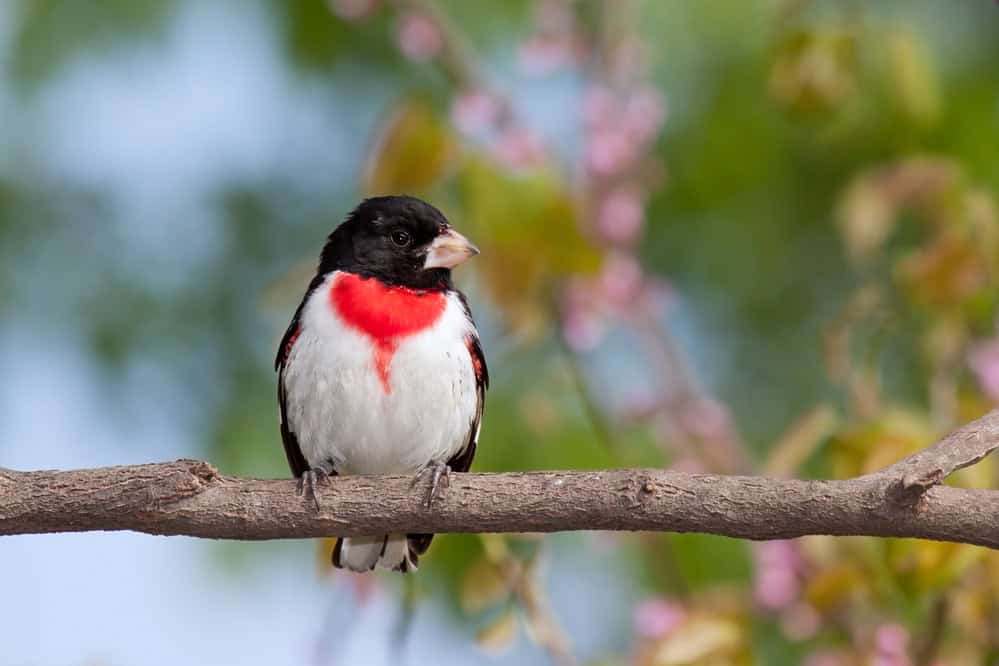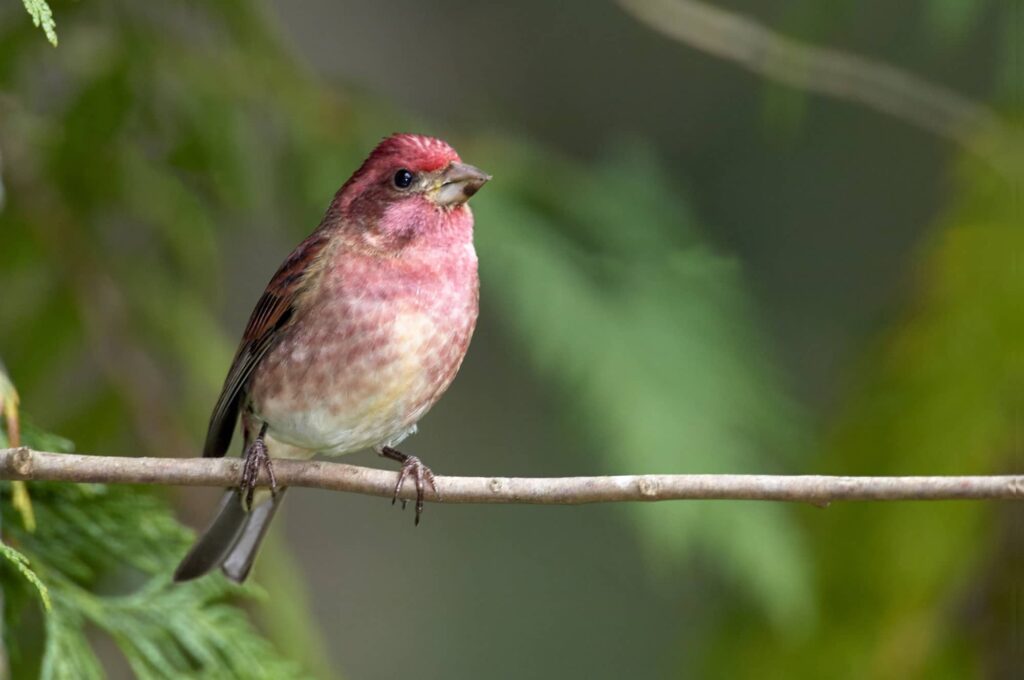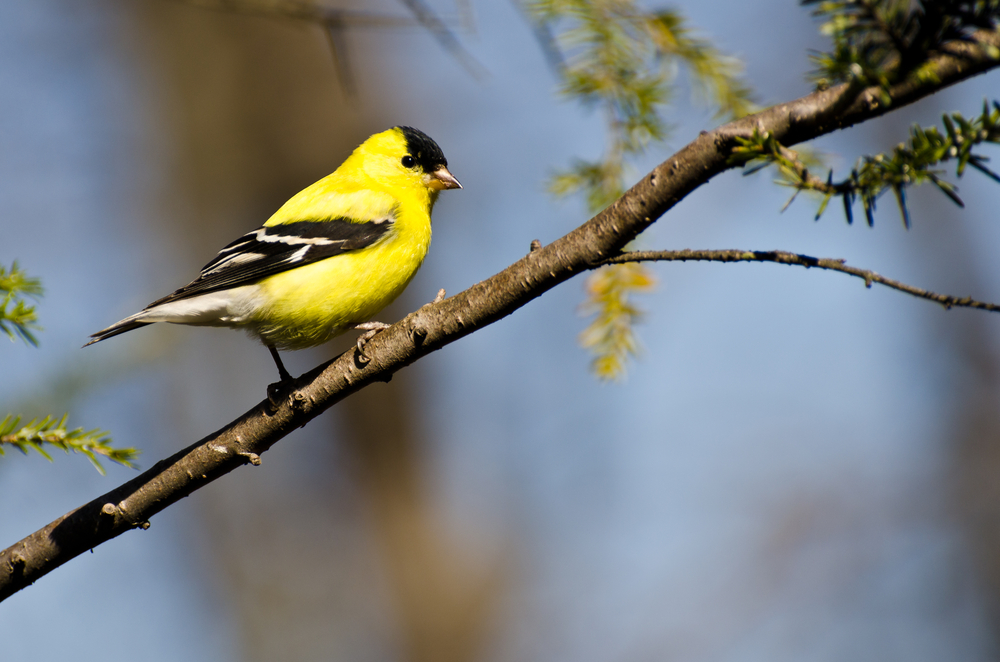When it comes to tropical-esque beaches and rainy weather, songbirds are one of the last animals people think of. Interestingly enough, there are 8 finch species you can spot in the Palmetto State.
Finches are fascinating in how adaptable they are to different environments. You can find them in boreal forests, subtropical climates, and people’s overgrown backyards.
If you’re thinking of doing a little birdwatching, we’ve got some tips to help you catch a glimpse of these charming species. You’ll learn how to spot each bird by their appearance, call, and more.
House Finch

- Species Name: Haemorhous mexicanus
- Length: 13 cm to 14 cm
- Weight: 16 grams to 27 grams
- Wingspan: 20 cm to 25 cm
South Carolina is brimming with gorgeous wildlife. You’d be hard-pressed not to see a few house finches hopping about the state’s beautiful parks and gardens.
Appearance
The male house finch has a blushing red head with a sleek brown body and a pale gray bill. Their slimmer body almost makes them appear like a sparrow at a glance, though they have very different coloration.
The female house finch has a light brown and white body covered in streaks. She also boasts a pale gray bill.
Range
The house finch isn’t a fan of migration, so expect to see this finch year-round. They’re comfortable in a wide variety of environments such as parks, fields, and backyards.
Diet
House finches will eat a variety of foods such as insects, berries, and seeds. They also nibble on flower buds and will not pass up an opportunity to chow down at a bird feeder.
You’ll easily attract house finches to your backyard or porch with nyjer and sunflower seeds. They’re fond of sock feeders and prefer to eat in large, noisy flocks.
Birdsong
These beautiful finches have a sweet and lively song composed of warbles, chitters, and tweets. It’s the kind of classic birdcall that reminds you why these species are dubbed songbirds.
Fun Fact
The house finch used to go by a very interesting name back in the day – the Hollywood finch. This term originated because of pet owners selling house finches illegally in the 1940s.
Pine Siskin

- Species Name: Spinus pinus
- Length: 11 cm to 14 cm
- Weight: 12 grams to 18 grams
- Wingspan: 18 cm to 22 cm
Another sparrow-like finch is the aptly named pine siskin. These finches earned their name for their voracious feeding habits in coniferous forests.
Appearance
Male pine siskins may not be as visually startling as other finches on this list, but I think they’re quite charming. They have a tan and yellow body covered in brown streaks.
Their narrow bill and forked tail give them an almost delicate look that blends in well with their favorite pine trees.
The female pine siskin looks quite similar to the male but with a little less yellow.
Range
With over 65% of the state covered in forests, it’s not surprising the pine siskin regularly makes its home here. This bird prefers to show up in South Carolina during the late fall and winter months.
Pine siskins frequently travel between forests and overgrown, shrubby areas. They don’t usually show up in more urban settings.
Diet
Pine siskins spend most of their day foraging for seeds in various coniferous trees. However, they’ll sometimes nibble on flower buds or visit bird feeders.
You’ll be able to invite over pine siskins with nyjer, thistle, or black oil sunflower seeds. I also recommend getting a suet feeder to give them some extra energy when it gets cold.
Birdsong
Pine siskins have one of the most unique calls in the finch family. They sound like they’re squealing with a long, shrill tzweee.
Fun Fact
These finches are all about specialization. Even their scientific name ‘pinus’ is Latin for ‘pine tree’.
Evening Grosbeak

- Species Name: Hesperiphona vespertina
- Length: 16 cm to 22 cm
- Weight: 38 grams to 86 grams
- Wingspan: 30 cm to 36 cm
What’s more beautiful than South Carolina’s quintessential oak trees? Seeing an evening grosbeak popping out against their curling brown branches.
Appearance
Male evening grosbeaks are quite a sight with their yellow body, black wings, and bold white wing bars. They have a permanent scowl thanks to a big yellow eyebrow.
The female evening grosbeak has a more olive-toned body with black wings and white wing bars. She has an interesting gray-green bill.
Range
These stocky birds are big fans of mountain ranges and forests, but they don’t mind visiting urban environments once in a while. The evening grosbeak needs a little planning beforehand since they usually show up during the winter.
While you won’t see much snow in South Carolina to contrast their plumage, I have a few tips on attracting them.
Diet
Evening grosbeaks switch up their diet frequently to reflect the seasons. They eat insects in the summer but switch to flower buds during the spring.
Since seeds have a higher fat content, they tend to frequent backyard feeders during the winter to stay warm. Stock up on sunflower seeds (and a little patience) to bring them over.
Birdsong
These finches have a rapidly rise-and-fall song composed of trills and the occasional chirp.
Fun Fact
The pine grosbeak is one of the heavier finches, so they’re more likely to visit your backyard if you have a platform feeder.
Blue Grosbeak

- Species Name: Passerina caerulea
- Length: 14 cm to 19 cm
- Weight: 26 grams to 31 grams
- Wingspan: 26 cm to 29 cm
This stunning finch immediately catches people’s eye for their unique plumage.
Appearance
The male blue grosbeak has a rich, berry blue body with brown wing bars. The black banding around their eyes almost makes them look like a blue jay at a glance.
The female blue grosbeak is almost like an inverted version of the male. She has a mostly brown body with light gray-blue wing bars.
Range
The blue grosbeak frequently dips in and out of overgrown areas (which are never lacking in South Carolina). You’ll see plenty along forest edges, shrubbery, thickets, and weedy fields.
They show up mainly during the breeding season, so jot down a note for your spring birdwatching checklist.
Diet
These finches are keen on overgrown areas because there are plenty of insects. They’ll eat everything from spiders to fruit.
If you want to attract these beautiful birds to your feeder, try to place sunflower seeds in an overgrown area. This more closely replicates their natural habitat and makes them feel more comfortable.
Birdsong
Their songs are as beautiful as their plumage. Expect to hear repeating warbles with the occasional tinny chirp.
Fun Fact
The blue grosbeak’s insect-heavy diet is a boon for farmers. They have a tendency to eat pests such as grasshoppers and weevils.
Common Redpoll

- Species Name: Acanthis flammea
- Length: 12 cm to 14 cm
- Weight: 11 grams to 20 grams
- Wingspan: 19 cm to 22 cm
If you’re eager for a birdwatching challenge while living in or visiting North Carolina, this is the finch for you. This species is accidental in the state, so it’ll be tricky to spot.
Appearance
The male common redpoll is quite a sight with his bold red forehead spot. He has a round tan body with a white stomach and a tiny, yellow conical bill.
He usually has a blushing chest that makes him stand out particularly well against snow and green trees.
The female common redpoll looks similar to the male but without the pink chest.
Range
The common redpoll rarely shows up in South Carolina because it’s a fan of arctic environments. They usually prefer weedy fields and rocky crevices.
Diet
These finches enjoy conifer seeds as well as alder and birch seeds. During the summer they’ll dive in and out of grasses to snatch insects.
If you’re patient (and lucky!), you’ll be able to attract these birds to your backyard with nyjer seeds.
Birdsong
While this tricky finch is hard to spot, it’s easy to identify both by sight and by sound. They have a distinctive cheet-cheet-cheet that often repeats.
Fun Fact
The common redpoll is frequently confused with the Arctic redpoll, a very similar-looking finch.
Rose-Breasted Grosbeak

- Species Name: Pheucticus ludovicianus
- Length: 18 cm to 22 cm
- Weight: 35 grams to 65 grams
- Wingspan: 29 cm to 33 cm
This stunning finch is a must-see sight in South Carolina. They have unique plumage that almost makes them look like a bird of paradise.
Appearance
The male rose-breasted grosbeak earned his name due to the cherry-red streak along his chest. The rest of his body is black with a white belly, white wing bars, and pale bill.
The female rose-breasted grosbeak looks similar to a common sparrow with her brown and white coloration. She has a large white eyebrow and a pinkish bill.
Range
Rose-breasted grosbeaks enjoy deciduous forests of any size and flavor. They enjoy dense forests just as much as forest edges, parks, and gardens.
Expect to see them in South Carolina during migration, though a few may occasionally visit during breeding season.
Diet
These colorful birds are avid foragers who regularly scrounge around for berries, seeds, and insects. They’re so swift they can catch insects mid-flight.
You’ll be able to attract a few to your birdfeeder with classics such as sunflower seeds. However, they’re also known to eat wheat and oats – just make sure they’re raw, not cooked!
Birdsong
These finches have a sweet and delicate song composed of brief warbles. They sound a little similar to an American robin.
Fun Fact
This finch has a vibrant mating dance composed of flying, singing, and fluffing up his feathers.
Red Crossbill

- Species Name: Loxia curvirostra
- Length: 14 cm to 17 cm
- Weight: 40 grams
- Wingspan: 25 cm to 27 cm
This finch is also a little tricky to spot since they usually prefer colder environments. Expect to only catch glimpses of this bird in northern South Carolina.
Appearance
The red crossbill is a quaint fellow with his unique crossed beak. He has a bright red body, gray-brown wings, and white wing bars.
However, adult males sometimes look red-orange or orange.
The female red crossbill leans toward a yellow-olive with gray-brown wings. She boasts the same crossed beak.
Range
These birds love coniferous forests where they can use their unique beak to slip into cones and tug out the seeds. They also sometimes dabble near roadsides to nibble on mineral salt, which rounds out their diet.
Diet
While seeds and road salt are their staples, they enjoy several other foods. They sometimes visit bird feeders to snack on suet, millet, or safflower.
Birdsong
This finch song is a long, jaunty twee-er twee-er with trills and chirps sprinkled in.
Fun Fact
Their scientific name curvirostra is a Latin word that means curved bill.
Purple Finch

- Species Name: Haemorhous purpureus
- Length: 12 cm to 16 cm
- Weight: 18 grams to 32 grams
- Wingspan: 22 cm to 26 cm
While this finch loves to roam around Eastern states and Canada, they show up in South Carolina primarily during the winter.
Appearance
The male purple finch is a juicy reddish pink with brown wings and a white belly. They have a forked tail and a pale bill.
The female purple finch looks like a classic brown finch with white speckles and a smaller bill.
Range
Coniferous forests are their favorite environments, though they’ll take root in just about any type of forested environment. Keep a close eye on the trees in late fall and early spring to spot a few.
Diet
Like many finches, the purple finch has a varied diet of insects, seeds, and berries. You may be able to attract a few in winter with millet or nyjer seeds.
Birdsong
This finch’s song is lilting and high-pitched, composed of rising and falling warbles. They sound a little like twee-er-twee-er-wee-err.
Fun Fact
Try not to get this bird confused with the house sparrow! Purple finches have more vivid coloration and a pale stomach.
American Goldfinch

- Species Name: Spinus tristis
- Length: 11 cm to 13 cm
- Weight: 11 grams to 20 grams
- Wingspan: 19 cm to 22 cm
Rounding off the list with one of the most popular songbirds, the American goldfinch is a common sight in South Carolina. This small, vibrantly-colored finch shows up north of the state year-round, but only in the south during breeding season.
Appearance
The male American goldfinch is a delightful bird with a yellow body, black wings, and white wing bars. They have a black ‘cap’ and a bright orange bill.
Male birds’ plumage will be brighter during the breeding season but will soften to a tannish-yellow the rest of the year.
The female American goldfinch is just as lovely with a yellow-olive body, black wings, and white wing bars. Even experienced bird watchers will confuse the males with the females.
Range
If you enjoy strolling through South Carolina’s many botanical gardens, keep an eye out. American goldfinches love overgrown gardens, parks, and well-tended backyards.
Diet
This cute bird enjoys foraging thistle and aster plants for vegetable matter and seeds. Unlike many other finch species, they don’t enjoy eating insects (but will make a few exceptions).
Attract these little beauties to your bird feeder with nyjer and sunflower seeds. I recommend using smaller backyard bird feeders for songbirds so they don’t get scared away by larger species.
Birdsong
The American goldfinch has a sweet call composed of short warbles and metallic cheeps.
Fun Fact
These finches love to travel in noisy flocks, making them a charming sight for casual backyard bird watching.
South Carolina Is a Whimsical State for Birdwatching Adventures
South Carolina’s unique climate and brilliant flora make it a prime spot for birdwatching. While a few of these finches are accidental species, most species are easy to spot.
If you live in South Carolina, you’ll be able to spot many by visiting gardens or keeping your bird feeder stocked with the classics. If you’re a visitor, I recommend visiting during the breeding season to glimpse blue grosbeaks.
You’ll be able to catch year-round species like American goldfinches and house finches, too!
If you want to learn more about South Carolina’s thriving bird population, never fear. We have a useful ‘birds in South Carolina’ guide to fill out your bird-watching list.

